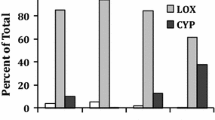Abstract
Aromatic hydroxylation from the reaction between hydroxyl radical and salicylate or its related compounds has been often utilized as a marker for the generation of hydroxyl radicals. We have investigated several technical aspects of applying this method to study hydroxyl radical production during cerebral ischemia and reperfusion using the hydroxylation of 4-hydroxybenzoic acid (4-HBA) to form 3,4-dihydroxybenzoic acid (3,4-DHBA). 4-HBA was administered to rats either through intravenous infusion, or by way of an in vivo microdialysis probe implanted in the brain. Dialysate containing 3,4-DHBA was collected and analyzed by HPLC with electrochemical detection. An endogenous compound was found to co-elute with 3,4 -DHBA but could be separated by varying the chromatographic conditions. Because of interrupted blood flow during cerebral ischemia and reperfusion, delivery of 4-HBA through the microdialysis probe is a preferred method to systemic administration such as intravenous infusion. It is concluded that the oxidation of 4-HBA to 3,4-DHBA can be a reliable and accurate indicator for the formation of hydroxyl radical in vivo if the experiments are well designed to avoid potential pitfalls associated with technical difficulties of the method.
Similar content being viewed by others
References
Acworth IN, Bogdanov MB, McCabe DR, Beal MF: Estimation of hydroxyl free radical levels in vivo based on liquid chromatography with electrochemical detection. Methods Enzymol 300: 297–313, 1999
Halliwell B, Gutterridge JMC: Free Radicals in Biology and Medicine, 2nd ed. Clarendon Press, Oxford, 1989, pp 30–55
Lancelot E, Calleuse J, Ravaude ML, Voulu RG, Plotin M: Detection of hydroxyl radicals in rat striatum during transient focal cerebral ischemia: Possible implication in tissue damage. Neurosci Lett 197: 85–88, 1995
Sloot WN, Gramsbergen JBP: Detection of salicylate and its hydroxylated adducts 2,3-and 2,5-dihydroxybenzoic acids as possible induces for in vivo hydroxyl radical formation in combination with catechol and indoleamines and their metabolites in cerebrospinal fluid and brain tissue. J Neurosci Methods 60: 141–149, 1995
Floyd RA, Henderson R, Watson JJ, Wong PK: Use of salicylate with high pressure liquid chromatography and electrochemical detection (LCED) as a sensitive measure of hydroxyl free radicals in adriamycin treated rats. Free Radic Biol Med 2: 13–18, 1986
Floyd RA, Watson JJ, Wong PK: Sensitive assay of hydroxyl free radical formation utilizing high pressure liquid chromatography and electrochemical detection of phenol and salicylate hydroxylation products. J Biochem Biophys Methods 10: 221–235, 1984
Grootveld M, Halliwell B: Aromatic hydroxylation as a potential measure of hydroxyl-radical formation in vivo. Biochem J 237: 499–504, 1986
Halliwell B, Kaur H, Ingelman-Sundberg M: Hydroxylation of salicylate as an assay for hydroxyl radicals: A cautionary note. Free Radic Biol Med 10: 439–441, 1991
Chiueh CC, Krishna G, Tulsi P: Intracranial microdialysis of salicylic acid to detect hydroxyl radical generation through dopamine autooxidation in the caudate nucleus: Effects of MPP+. Free Radic Biol Med 13: 581–583, 1992
Zini I, Tomasi A, Grimaldi R, Vannini V, Agnati LF: Detection of free radicals during brain ischemia and reperfusion by spin trapping and microdialysis. Neurosci Lett 138: 279–282, 1992
Kil HY, Zhang J, Piantadosi CA: Brain temperature alters hydroxyl radical production during cerebral ischemia/reperfusion in rats. J Cereb Blood Flow Metab 16: 100–106, 1996
Obata T, Yamanaka Y: Intracranial microdialysis of salicylic acid to detect hydroxyl radical generation by monoamine oxidase inhibitor in the rat. Neurosci Lett 188: 13–16, 1995
Ste-Marie L, Boismenu D, Vachon L, Montgomery J: Evaluation of sodium 4-hydroxybenzoate as an hydroxyl radical trap using gas chromatography-mass spectrometry and high-performance liquid chromatography with electrochemical detection. Anal Biochem 241: 67–74, 1996
McCabe DR, Maher TJ, Acworth IN: Improved method for the estimation of hydroxyl free radical levels in vivo based on liquid chromatograph with electrochemical detection. J Chromatogr B 691: 23–32, 1997
Bogdanov MB, Ramos LE, Xu Z, Beal MF: Elevated 'hydroxyl radical' generation in vivo in an animal model of amyotrophic lateral sclerosis. J Neurochem 71: 1321–1324, 1998
Longa EZ, Weinstein PR, Carlson S, Cummins R: Reversible middle cerebral artery occlusion without craniectomy in rats. Stroke 20: 84–91, 1989
Guido G, Crooner T, Welch T: The effect of α-phenyl-tert-butyl intone (PBN) on free radical formation in transient focal ischemia measured by microdialysis and 3,4-dihydroxybenzoate formation. Acta Physiol Scand 168: 277–285, 2000
Author information
Authors and Affiliations
Rights and permissions
About this article
Cite this article
Liu, M., Liu, S., Peterson, S.L. et al. On the application of 4-hydroxybenzoic acid as a trapping agent to study hydroxyl radical generation during cerebral ischemia and reperfusion. Mol Cell Biochem 234, 379–385 (2002). https://doi.org/10.1023/A:1015998732066
Issue Date:
DOI: https://doi.org/10.1023/A:1015998732066



